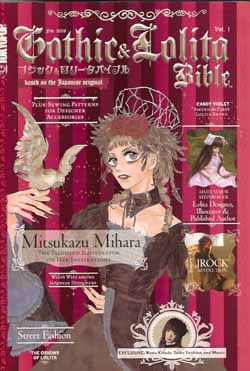
By various (TokyoPop)
ISBN: 978-1-42780-347-1
I’m always happy to see new ways to cross the divide between comics – of any nationality – and the broader world so this odd but interesting (to wizened codger me, at least) new art book from those fine people at TokyoPop gets my nod.
For those of you who have no idea what “Gothic†and “Lolita†means in this context, allow me to enlighten you.
Young people–and especially Japanese folk–like to dress up. They call it “Cos Playâ€. That’s a recreational choice. This book is devoted to a stylisation that probably grew out of that but more directly devolves from music fans copying the way their favourite Visual Kei bands dressed. Visual Kei is a music genre where performers all play in a themed uniform or costume – like the Beatles in 1964 or the Hives last week. This mimicry has become an actual fashion movement in its own right.
The Gothic part is much like what you’re used to, a subculture concerned with alienation, which borrows equal parts from Elizabethan and Victorian/Edwardian clothing styles and vampire imagery ranging from the German Expressionists to Hammer films. There’s lots of black and some red and/or white. Many outsiders assume Goths are obsessed with death and nihilism, and just like when I was a punk in the late 1970’s (don’t visualise, just move on) assume the clothes are a uniform rather than a lifestyle choice. By most accounts Goths are concerned with issues of change, transformation, free expression, conscious eroticism and austere or “cold†beauty.
Lolita in this context means wearing outfits that have visual roots in Victorian and Edwardian children’s clothing or Rococo period fashion and accessories. In Japan Roriita Fasshon is a thriving subculture with many competing companies producing apparel and millions of young people designing their own personal outfits.
The basic kit includes knee length socks or stockings, flounced skirts and dresses, ornate headdresses, blouses and petticoats plus insanely high heel/platform shoes or boots… and very specific make-up. The emphasis is on innocence and idyllic childhood, so there’s often a teddy bear or toy in attendance.
Lolita subdivides into a number of branch styles such as Gothic, Elegant Gothic, Sweet (or amaloli: based on Rococo art styles and heavily influenced by Alice in Wonderland and shojo manga – I said there was a comic connection, didn’t I?), Country (more Dorothy in Oz than Alice in Looking Glass Land), Classic (which is intricate and Baroque influenced) and even Punk.
This oversized tome is filled with translated articles produced between 2004 to 2006 culled from Japanese magazines on the subject as well as original American contributions, hundreds of photos, poetry, fan art and designs, and a rather good complete original manga tale: Till Dawn is by Asumiko Nakamura and details the surreal yet poignant meeting of a Goth boy and a Lolita girl. This edition also includes a set of patterns for the home hobbyist to make their own Loli-Goth accessories.
Not, I suspect, everybody’s cup of tea but an intriguing project that might pull in a few fashion-conscious fans to our weird graphic playground. And all you comic he-men shouldn’t worry; I read the entire thing and felt absolutely no desire to put on a petticoat (what did I say about not visualising…?!)
© 2007 TokyoPop, by arrangement with Index Communications. All Rights Reserved.
